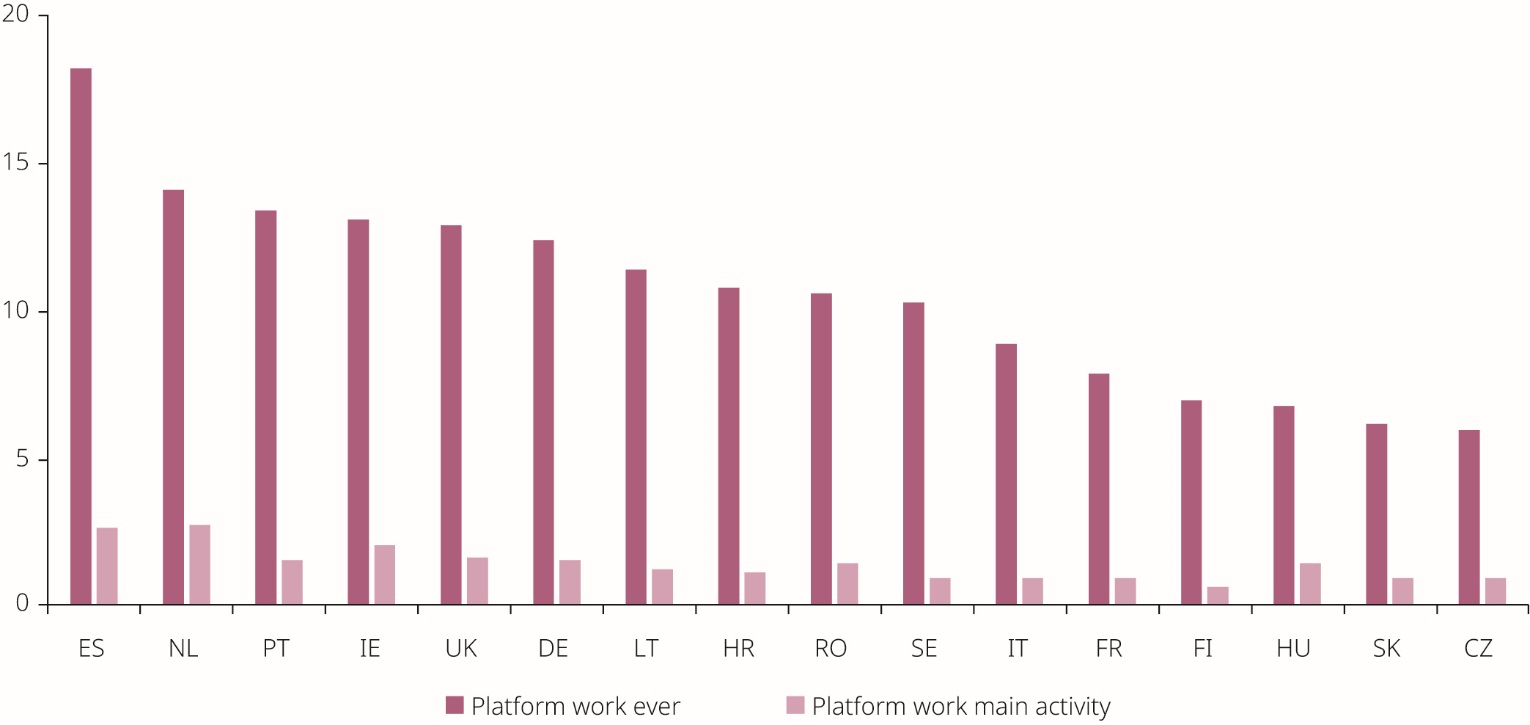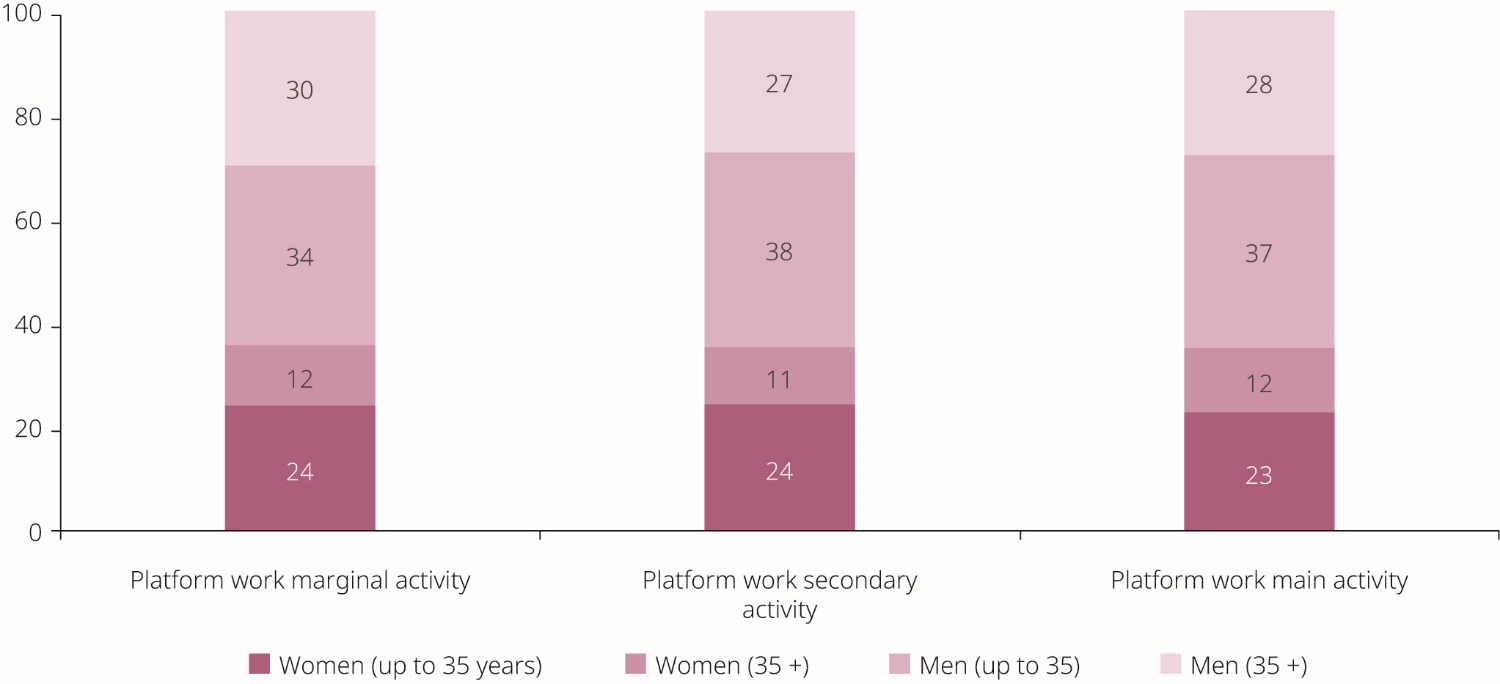Employment prospects in the ICT sector and platform work
Apart from its potential to replace human work, digitalisation offers a range of new opportunities, either by transforming existing jobs or creating entirely new ones. Access to such opportunities is likely to be highly gendered, given the segregated nature of the EU labour market, the variety of gender stereotypes around employment in certain jobs and related gender differences in career expectations. This section analyses the differences in participation of women and men in two quite different types of job opportunities linked to digitalisation.
Firstly, the increasing digitalisation of work has created a growing demand for high-skilled workers with advanced digital skills, apparent across all economic sectors. This section looks in particular at the job prospects of women and men in the ICT sector, in view of the high demand for ICT specialists during the past decade or so (Eurostat, 2019b) and the fact that the workforce remains male dominated.
Perhaps less obvious is the fact that digitalisation enables the creation of a broad range of low-skilled opportunities, for example in the context of certain forms of platform work. While platform work includes some well-paid, high-skilled opportunities (Eurofound, 2018b), there are many poorly paid jobs that serve only to supplement income from other sources (Huws et al., 2019; ILO, 2018c; JRC, 2018). Women are currently under-represented in platform work, with the employment structure following the well-established patterns of gender segregation in the broader economy.
Definition of platform work
There are many definitions of platform work, resulting in a lack of consistency in the use of the term. This report adopts Eurofound’s understanding of platform work as a ‘form of employment that uses an online platform to enable organisations or individuals to access other organisations or individuals to solve problems or to provide services in exchange for payment’ (Eurofound, 2018b, p. 9). According to this definition, platform work has several key features:
- paid work is organised through an online platform;
- three parties are involved: the online platform, the client and the worker;
- the aim is to carry out specific tasks or solve specific problems;
- the work is outsourced or contracted out;
- jobs are broken down into tasks;
- services are provided on demand.
Generally, platforms can be divided into those where work is delivered purely online (e.g. Amazon Mechanical Turk) and those where work is delivered on-site (e.g. Uber). The most common tasks performed include (1) professional tasks (e.g. software development or translation); (2) transport (e.g. personal transport or food delivery); (3) household tasks (e.g. cleaning or plumbing); and (4) micro tasks (e.g. tagging images online).
Full potential of the ICT sector cannot be realised without gender equality
Recent decades have seen EU Member States gradually transform their labour markets, reflecting the trends towards digitalised and knowledge-based economies. The STEM sector and in particular the ICT sector have increased in importance in the overall economy and secured their status as providing well-paid, secure and high-quality jobs. From 2008 to 2018, the growth in employment of ICT specialists was more than 12 times the average employment growth in the EU, with the share of ICT specialists in total employment increasing by 1.1 p.p. (from 2.8 % to 3.9 %) (Eurostat, 2019b).
The ICT sector was one of the few that withstood the effects of the financial crisis and continued to experience growth. However, of the 9 million ICT specialists, only around 18 % are women, and the share of women in ICT jobs in the EU has decreased by 4 % since 2010 (see subsection 9.1.3).
Even larger growth of the ICT sector has been limited by the substantial mismatch between high demand and relatively low supply of ICT specialists in the EU labour market. The majority of EU Member States report difficulties in finding a sufficient number of science, engineering and ICT professionals (European Commission, 2014a).
A recent estimate suggested that the EU faced a shortage of some 600 000 ICT specialists in 2018 (European Commission, 2018h). This mismatch between the supply of ICT specialists and employer demand is likely to remain for some time, as STEM specialists and in particular ICT specialists continue to be in high demand (Cedefop, 2018).
With the ICT sector heavily gender segregated and facing a huge demand for new specialists, the greater involvement of women seems to be a policy strategy with obvious economic and social benefits. EIGE has estimated that attracting more women into the STEM and ICT sectors would lead to economic growth in the EU, with more jobs (an increase of up to 1.2 million by 2050) and an increase in GDP over the long term (by up to EUR 820 billion by 2050) (EIGE, 2017c).
Growth in personal and household services provided via platforms could support women’s employment
The platform economy[1] in the EU is, as yet, a relatively small phenomenon. In 2015, revenue in the five key sectors of the platform economy[2] were estimated at roughly EUR 4 billion (European Commission, 2019b), with the highest revenues recorded for peer-to-peer transport (EUR 1.7 billion) and accommodation (EUR 1.2 billion). These revenues were predicted to grow rapidly in the coming years (PwC, 2016), but this may turn out to be overly optimistic in the light of the COVID-19 pandemic.
The scant early information on the impacts of the COVID-19 pandemic on the platform economy available at the time of writing indicates that there will be negative consequences. Early survey statistics published by the World Economic Forum[3] show that, globally, as much as half of platform workers may have lost their jobs, and a further 26 % have seen their working hours decrease.
The impacts on certain on-site services, such as ride-hailing or accommodation rental, seem to have been particularly damaging[4]. Other services, such as delivery or online work, appear to be less affected[5]. However, there are some concerns about the influx of newly unemployed people into the platform economy, resulting in lower wages and reduced work available per worker[6].
Despite the uncertainty about future growth of the platform economy, it is interesting to note that on-demand personal and household services (cooking, cleaning, plumbing, etc.) were estimated to have the highest growth potential (PwC, 2016). This suggests that there is considerable demand for outsourcing unpaid domestic work via platforms. This could support the labour market participation of women (Overseas Development Institute, 2019).
Highly qualified women whose participation in the labour market is held back by their disproportionate share of unpaid work may decide to outsource this work, often to poorer women from migrant backgrounds (EIGE, 2020a). However, questions remain about the domestic tasks most likely to be outsourced and under what working conditions (see subsection 9.2.3).
Serious concerns have been raised about the precarious, exploitative nature of domestic work provided by women, especially when they are excluded from safe employment as a result of their legal migration status or discrimination (European Parliament, 2017; FRA, 2018).
Platform work seems to reproduce the usual gender segregation patterns
While data on platform work in the EU is incomplete and difficult to compare, it suggests that a relatively small share of the EU population is involved in platform work. From three recent surveys carried out in multiple EU Member States (Huws et al., 2019; JRC, 2018, 2020a), it appears that around 10 % of the EU population has ever provided some services via platforms. This constitutes the main employment activity of only around 2 % of the population. The share of platform work varies substantially by country (Figure 44).
The majority of platform workers dedicate only a few hours a week to this work and use it to supplement income from other, more important sources (Huws et al., 2019; JRC, 2018, 2020a). Their work often consists of several tasks on different platforms that top up their income from primary jobs. Thus, a substantial share of platform workers seem to piece together their livelihood from whatever opportunities may bring extra money, using platform work as a minor income supplement to improve their economic situation.
Figure 44. Percentages of the adult population participating in platform work, by country, 2017
Platform workers deliver a broad range of services, the provision of which mostly seems to follow well-known patterns of gender segregation. Services can be broadly divided into those delivered purely online (e.g. software development or tagging of images online) and those requiring a physical presence on location (e.g. cleaning or personal transport)[7]. Most platform workers in the EU are engaged in online professional tasks (e.g. accounting, legal services, project management services or translation) and clerical tasks (e.g. customer service, data entry or transcription) (Huws et al., 2019; JRC, 2018, 2020a).
The survey data indicate that gender plays an important role when choosing which services to provide: for example, men dominate in software development and transport services, whereas women work more frequently in certain on-site services, such as personal or household services, and in translation (JRC, 2018).
Women are under-represented in platform work
Based on the most recent EU data, around one in three platform workers are women, regardless of platform work intensity (JRC, 2020a) (Figure 45). The share of women who undertake platform work as a main or secondary activity has increased somewhat since 2017. Platform workers are usually young and well educated, and their educational attainment often exceeds that required for the low-skilled nature of certain types of platform work (ILO, 2018c; JRC, 2018).
As many as half of platform workers live in a couple with children, often aged under 5 (ILO, 2018c; JRC, 2018, 2020a). Based on global data on online platform work, the proportion of workers with small children at home appears to be much higher among women, who also more frequently report the need to work from home to combine work with caring responsibilities (see subsection 9.2.4). Platform work can give them an additional opportunity to do this.
Figure 45. Percentages of women and men in platform work by intensity, EU, 2018
Yet such generalisations obscure a lot of diversity among the platform workforce, whose composition often depends on the specific platform and type of service provided.
- Some (United States-based) studies indicate that workers who rely on low-wage platform work as a main source of income often come from low-income, less educated households and are more likely to have minority ethnic backgrounds (Smith, 2016; Van Doorn, 2017). Most recent EU data indicates that around 15 % of platform workers are foreign born, a higher proportion than in overall employment (JRC, 2020a).
- Online platform work performed from home also offers opportunities for people with health limitations that prevent them from working outside the home. A global survey found that almost one in five online platform workers reported health limitations (ILO, 2018c).

